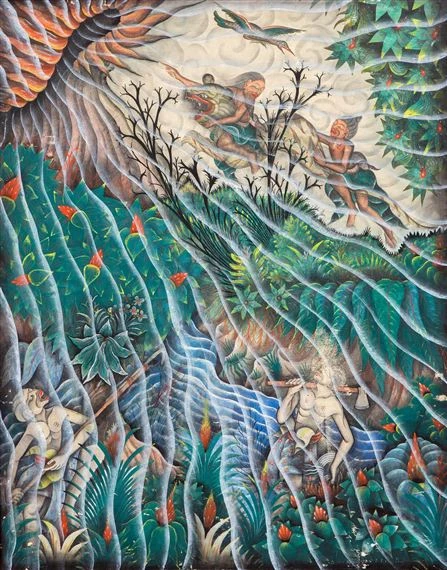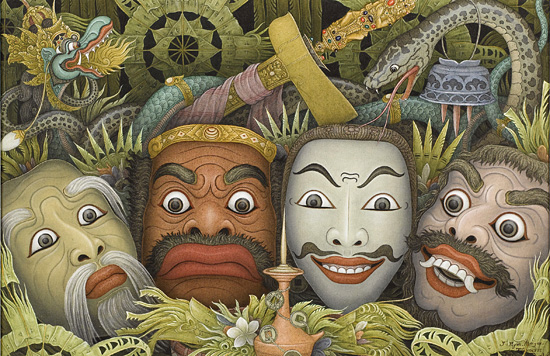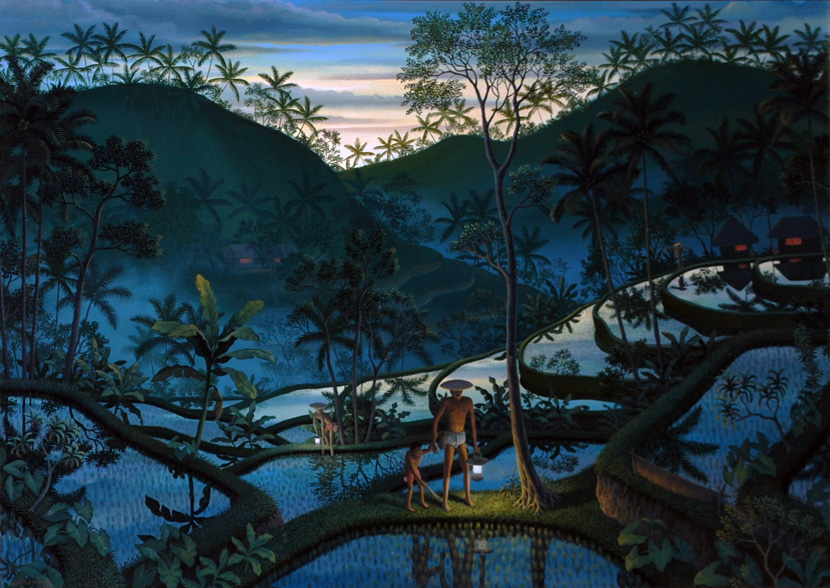Ubud School of Painting
Dewa Nyoman Leper, Hanuman Duta

Ubud has been the center of art for centuries with the surrounding royal houses and temples as the main patrons. Prior to 1920s, traditional wayang style paintings dominated the subject matters, although Jean Couteau (1999) believes that both the secular and religious theme paintings have long been co-existing as the unity of the opposites (Rwa bhinneda in Balinese belief system).
It was not until the late 1920s that this balance was tilted toward secular art by the arrival of western artists such as Covarrubias, Le Mayeur de Mepres, Theo Meier, Walter Spies and Rudolf Bonnet. The last two artists were often credited as the agents of change that brought Balinese Art to modernity. Their influence culminated with the founding of the Pitamaha Art Guild in 1936, with Tjokorda Gde Agung Sukawati as one of the founders. Its mission was to preserve the quality of Balinese Art in the rush of tourism to Bali. The board members of Pitamaha met regularly to select paintings submitted by its members and conducted exhibitions throughout Indonesia and abroad. Pitamaha was active until the beginning of the second world war in 1942.
The influence of Bonnet and Spies were most welcome and flourished in Ubud, and naturally Ubud artists were most influenced by them. The subject matters shifted from religious narration to Balinese daily life capturing all aspects of ordinary life in Bali. Ubud artists who were members to Pitamaha came from Ubud and its surrounding villages: Pengosekan, Peliatan and Tebasaya. Among them were: Ida Bagus Made Kembeng of the village of Tebasaya and his three sons — Ida Bagus Wiri, Ida Bagus Made and Ida Bagus Belawa; Tjokorda Oka of the royal house of Peliatan; I Dewa Sobrat, I Dewa Meregeg, I Dewa Putu Bedil, I Dewa Dana of Padangtegal; I Gusti Ketut Kobot, I Gusti Made Baret, I Wayan Gedot, Dewa Putu Mokoh of Pengosekan; and I Gusti Nyoman Lempad.
The contemporary Ubudian artists include I Ketut Budiana, I Nyoman Meja, I Nyoman Kayun, A.A. Gde Anom Sukawati, I Gusti Agung Wiranata, Ida Bagus Sena, and many others. The spirit of Pitamaha is well preserved by these artists, as illustrated below by an early work of I Nyoman Meja.
I Gusti Agung Wiranata first learnt painting from his father and the only modern traditional Balinese painter who chose oil painting as his medium of expression. He learnt to paint in the style of Walter Spies through the book by Rhodius and Darling. Although their techniques are similar, Wiranata paintings are realistic depiction of the nature and activities around his village. The painting below shows a father and his son catching eels at dusk in the rice field. The artist skillfully captures the delicate contrast between dark and light and the tenderness between the father and son.
The incredible detail of Deblog’s drawings is an evidence of the skills he acquired during his collaboration with the photographer Yap Sin Tin. His works reveal a passionate sense of beauty, rendered with refined presence of a deeper reality of the world around us.
Selected Works

Tumpak Landep (1979),
Acrylic on Canvas, 60 x 90 cm

Catching eels at dusk, Oil on Canvas, 135 x 90 cm
On loan to the Museum Puri Lukisan, Ubud,
Bali – Indonesia

Ink on paper, 38 x 29 cm
